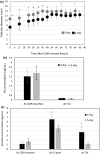Comparison of follicular development, timing of ovulation and serum progesterone, estradiol and luteinizing hormone concentrations in dairy heifers treated with 4- or 5-day CoSynch + CIDR protocols
- PMID: 31006992
- PMCID: PMC6682797
- DOI: 10.1002/vms3.171
Comparison of follicular development, timing of ovulation and serum progesterone, estradiol and luteinizing hormone concentrations in dairy heifers treated with 4- or 5-day CoSynch + CIDR protocols
Abstract
The use of 4-day CoSynch + Controlled internal drug release (CIDR) + timed artificial insemination (TAI) in dairy heifers has resulted in adequate pregnancy rates compared with the 5-day CoSynch + CIDR + TAI protocol. The objective of this study was to compare follicular growth, timing of ovulation and serum progesterone (P4 ), estradiol (E2 ) and luteinizing hormone (LH) concentrations in dairy heifers treated with modified 4- or 5-day CoSynch + CIDR protocols (CIDR for 4 or 5 days, PGF2 α at CIDR removal and GnRH + TAI 72 h later). Twelve cycling Holstein heifers were randomly assigned to either the 4- or 5-day Co-Synch+CIDR (n = 6/treatment) to receive an intravaginal insert CIDR® containing 1.38 g of P4 for 4 or 5 days, respectively. At CIDR removal, 25 mg of PGF2 α was injected IM; 72 h after CIDR removal, heifers received 100 μg of GnRH IM and timed artificial insemination (TAI). Follicular growth and timing of ovulation were assessed using transrectal ultrasonography. Blood samples were collected at the time of CIDR insertion and at frequent time points after CIDR removal for determination of P4 (at TAI), E2 (every 12 h) and LH (every 6 h during the first and second day and every 2 h on the third day). Heifers in the 4-day group had smaller follicles from CIDR insert removal to ovulation compared with heifers in the 5-day treatment. Five of six heifers (83.3%) in the 4-day treatment ovulated at 90-96 h post CIDR insert removal, whereas most heifers in the 5-day treatment (4/6; 66.6%) ovulated at 84-90 h post CIDR insert withdrawal. Heifers in the 5-day treatment reached greater peak LH concentration between 48 and 72 h after CIDR insert removal and lesser E2 concentration at TAI than heifers in the 4-day treatment. In conclusion, heifers in the 4-day treatment had smaller follicular diameter at 0, 30, 36, 42 and 48 h after CIDR insert removal, longer interval from CIDR insert removal to ovulation, greater E2 concentrations at TAI, and lesser peak LH concentration than heifers in the 5-day treatment. These results represent a baseline for further studies to determine if prolonging the interval to TAI by 6 h in the 4-day CoSynch+CIDR would improve pregnancy risk.
Keywords: CIDR; Co-Synch; Dairy heifer; Estradiol; Luteinizing hormone; Ovulation.
© 2019 The Authors. Veterinary Medicine and Science Published by John Wiley & Sons Ltd.
Conflict of interest statement
The authors of this article have no conflicts of interest.
Figures



References
-
- Bao B. & Garverick H.A. (1998) Expression of steroidogenic enzyme and gonadotropin receptor genes in bovine follicles during ovarian follicular waves: a review. Journal of Animal Science 76, 1903–1921. - PubMed
-
- Bleach E.C., Glencross R.G., Feist S.A., Groome N.P. & Knight P.G. (2001) Plasma inhibin A in heifers: relationship with follicle dynamics, gonadotropins, and steroids during the estrous cycle and after treatment with bovine follicular fluid. Biology of Reproduction 64, 743–752. - PubMed
-
- Bridges G.A., Mussard M.L., Burke C.R. & Day M.L. (2010) Influence of the length of proestrus on fertility and endocrine function in female cattle. Animal Reproduction Science 117, 208–215. - PubMed
-
- Busch D.C., Atkins J.A., Bader J.F., Schafer D.J., Patterson D.J., Geary T.W. & Smith M.F. (2008) Effect of ovulatory follicle size and expression of estrus on progesterone secretion in beef cows. Journal of Animal Science 86, 553–563. - PubMed
-
- Colazo M.G. & Ambrose D.J. (2011) Neither duration of progesterone insert nor initial GnRH treatment affected pregnancy per timed‐insemination in dairy heifers subjected to a Co‐synch protocol. Theriogenology 76, 578–588. - PubMed
Publication types
MeSH terms
Substances
LinkOut - more resources
Full Text Sources

